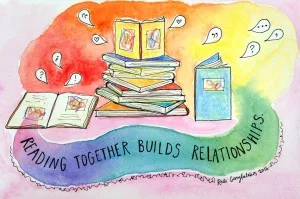As school is winding down for the year, you may be thinking about goals for summer vacation. Today we’re suggesting one simple thing: reading stories with your kids! Even if you are not a parent, chances are that there are some special kids in your life – perhaps nieces, nephews or family friends – who would love to read a book with you.
Much has been written by educators, helping professionals, and pediatricians about the benefits of reading aloud to children from as early as infancy. Amidst the many benefits for brain development and reading preparedness, reading together provides opportunities to build relationships. When summarizing a study by the American Academy of Pediatrics about the benefits of reading to children, Dr. Pamela High stated, “We feel that the power of the experience of reading to children is really seated in the relationship between the [caregiver] and the child, that this is the way of building that relationship. And we know that it’s really… nurturing relationships between caregivers and children that set a positive life course” (“I is for Infant: Reading aloud to young children benefits brain development.” www.pbs.org; June 14, 2014).
To elaborate on the relational aspect of reading together, here are three ways that sharing a story can build your relationships with the little ones in your life:
- Reading together is an opportunity for positive connection. Story time is a unique one-on-one opportunity for a child to experience the caregiver’s undivided and uninterrupted attention. It’s a screen-free activity that usually involves sitting close or cuddling, providing an opportunity for physical proximity that even older, physically active children often still crave from time to time. Reading a book together can be a nurturing, calming activity. Turning pages, reading words, and looking at pictures requires that we slow down and focus. Doing this together with a child provides an opportunity for the child to experience your calm presence and to relax and focus beside you. You can take advantage of this – maybe story time happens before bed, or after a temper tantrum, or when there are just too many fun activities and the choices have become overwhelming. Rather than story time being a used as a punishment or time out, the hope is that it’s an enjoyable experience and an opportunity to reconnect and re-set those positive bonds, which is beneficial at any time but especially after experiences of disconnection in the relationship. Silly, playful books are great for this – here are a few we enjoy:
- Orange Pear Apple Bear by Emily Gravett – it’s simple, silly, and delightful.
- Beautiful Oops! by Barney Saltzman – spills and messes get turned into masterpieces.
- The Cow that Laid an Egg by Andy Cutbill – a funny book with an underlying theme of acceptance.
- The Day the Crayons Quit by Oliver Jeffers & Drew Daywalt – each colour of crayon has a different reason, but they’ve all quit! Duncan opens his crayon box to discover their letters of resignation.
- Reading together is an opportunity to teach and learn new knowledge. Books that are developmentally appropriate present new information in ways that kids can understand. Exposure to different kinds of books expands vocabulary and increases factual knowledge for all ages. One great way to utilize this opportunity is to read books about emotions. We’ve listed a few of our favourites below. By reading books about emotions, you are teaching kids that everyone has all kinds of emotions, and you are also providing them with the language and vocabulary to be able to talk about their own emotions. The stories model different ways of communicating emotion, and children learn through modeling.
- In My Heart: A Book of Feelings by Jo Witek – this book goes through a wide range of emotions and demonstrates what kids might do or what they might need when they have those feelings. Ultimately it affirms that all feelings are okay.
- The Color Monster: A Pop-Up Book of Feelings by Anna Llenas – monster’s feelings are all mixed up. He needs some help to sort them out and label them.
- Mouse Was Mad by Linda Urban – the different animals have all sorts of ways to show that they’re mad. Mouse doesn’t know how to show that he’s mad, but through the story he figures it out.
- Tough Guys (have feelings too) by Keith Negley – with graphic illustrations of superhero characters who aren’t afraid to show their emotions, this book teaches kids that we all have feelings and it’s okay to express them.
- Reading together provides an opportunity to explore important topics together. Books that tell stories about a potentially stressful upcoming event, a developmental milestone, or a prominent experience in the child’s life can serve several functions. First, these stories normalize the experiences for the child and let him or her know that they’re not the only one who feels nervous about starting school, or afraid of the dark. Second, the stories model possible solutions to the problem or suggest new problem solving methods. They provide examples of characters who have made it through the situation, along with examples of how other characters have provided comfort or support in similar situations. Thirdly and most importantly, the books bring up the topic within the safe space of story time – a time when the child has your undivided attention in a calm setting. The books can serve as a starting point for conversation with the child about the topic and how it relates to his or her own experiences and emotions. Below you’ll find a few examples of books that address important topics.
- The Cloud by Hannah Cumming – this story explores depression in a kid-friendly way.
- It’s Okay to be Different by Todd Parr – a book celebrating diversity.
- Dinosaurs Divorce: A Guide for Changing Families byLaurie Krasny Brown and Marc Brown – this story provides practical information as well as emotional support for families experiencing separation or divorce.
- Scaredy Squirrel book series by Melanie Watt – Scaredy Squirrel is afraid of almost everything, but he always finds a way to work through his fears.
- The Heart and the Bottle by Oliver Jeffers – this poetic story explores loss in a symbolic way.
- The Scar by Charlotte Moundlic – a story about a child dealing with grief following his mother’s death.
- Ish by Peter H. Reynolds – this story about a little boy who suddenly decides that he can’t draw. It celebrates the idea that getting things “ish” is more important than getting them right.
Aside from the ways that it can benefit your relationship, reading together can also just be really fun! It can be a playful, interactive activity where the caregiver and child can be silly and enjoy each other’s company. If you’re wondering how to make story time fun, here’s a link to an article with some tips around how to make reading accessible for kids of different ages: http://www.raisesmartkid.com/all-ages/1-articles/52-reading-to-children-how-tos-and-tips
We’ve shared some of our favourite books throughout this post – what’s on your summer reading list?
Written by Rubi Garyfalakis,
Art Therapist at Art as Therapy.
References:
http://www.huffingtonpost.ca/2013/09/30/5-benefits-of-reading-for-kids_n_4018741.html
http://www.teachreadingearly.com/benefits-of-early-reading.php
http://www.pbs.org/newshour/bb/infant-reading-aloud-young-children-benefits-brain-development/
http://www.raisesmartkid.com/all-ages/1-articles/14-the-benefits-of-reading-to-your-child
http://www.rif.org/us/literacy-resources/articles/reading-with-your-child.htm

